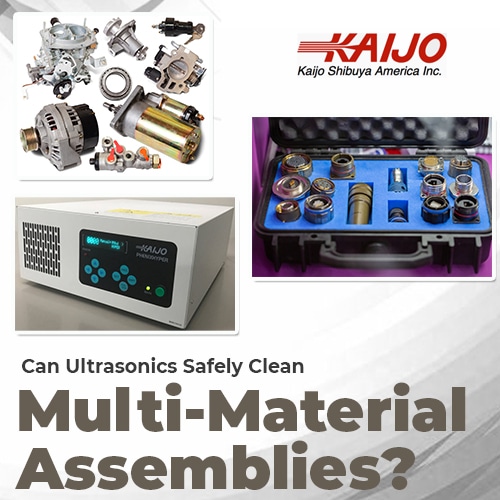Can Ultrasonics Safely Clean Multi-Material Assemblies?
Written by: Site Manager | October 12, 2021
 When ultrasonic technology is used to clean parts made of several materials, choosing the right ultrasonic cleaner becomes more challenging. Cleaning multi-material assemblies have become common in areas such as the automotive industry, and automotive ultrasonic cleaners have to be configured to handle these tasks. Features, settings, and characteristics of the ultrasonic systems have to be optimized for each material to ensure that cleaning is effective and possible product damage is avoided.
When ultrasonic technology is used to clean parts made of several materials, choosing the right ultrasonic cleaner becomes more challenging. Cleaning multi-material assemblies have become common in areas such as the automotive industry, and automotive ultrasonic cleaners have to be configured to handle these tasks. Features, settings, and characteristics of the ultrasonic systems have to be optimized for each material to ensure that cleaning is effective and possible product damage is avoided.
Components of harder metals can withstand energetic cleaning at low frequencies while softer metal surfaces such as aluminum, may suffer erosion or pitting. Delicate electronics may be damaged physically if the wrong frequency is chosen, but a too high frequency may not remove all contamination from part surfaces. When complex multi-material assemblies have to be cleaned with ultrasonics, an experienced ultrasonic cleaning system manufacturer can help ensure the chosen cleaner can deliver effective cleaning without damaging the parts.
How Ultrasonics Can Clean the Different Materials of an Assembly
Ultrasonic systems are made up of ultrasonic generators, transducers, and cleaning tanks. The ultrasonic generators produce a high-frequency electrical signal that the transducers convert to sound waves in the tanks. The choice of frequency depends on the materials to be cleaned and the nature of the contaminants to be removed.
Lower frequencies deliver powerful cleaning suitable for the fast removal of heavy contamination, but the intense cleaning action may damage soft or delicate materials. Higher frequencies can produce gentle cleaning but are slow to remove stubborn dirt. The key to successful ultrasonic cleaning is to balance the effects of the cleaning on the most fragile material with the cleaning power needed for a good cleaning.
For some contaminants, it is possible to add a mild detergent to the cleaning tank. The use of detergents improves cleaning and allows the use of high frequencies for the fragile materials that may be present in an assembly. The combination of gentle cleaning with higher frequencies and the use of detergents can result in excellent cleaning performance that avoids damaging parts made of softer materials.
When removing heavy contamination of oil and hardened grease deposits from automotive parts, heating the cleaning solution in the tank can soften the contaminants and make them easier to remove. Automotive ultrasonic cleaners sometimes have to clean multi-material assemblies such as parts containing electronic sensors or automatic transmission components. Heating the cleaning solution improves cleaning performance even when higher frequencies have to be used because the parts to be cleaned contain soft or delicate components.
Kaijo Can Help Customers Make the Best Ultrasonic Cleaning Choices
To obtain the best cleaning possible, multi-material assemblies have to be cleaned at the right ultrasonic frequency, taking into account whether the cleaning system uses mild detergents in the cleaning tank and whether the tank is heated. If the frequency is too low, soft materials or materials with delicate coatings could suffer pitting while fragile components might be damaged. If the frequency is too high, cleaning will be slow and possibly incomplete.
With extensive expertise gained by designing and building all ultrasonic cleaning components in-house, Kaijo can help customers with choosing the best ultrasonic cleaning system for their application. In addition to a free consultation, Kaijo also backs up its recommendations with products from a complete line of ultrasonic cleaners. Kaijo can advise on the choice of frequency and recommend whether detergents and/or heating should be used. As a leading manufacturer of ultrasonic cleaning products, Kaijo works with many customers from a variety of industries that have unique cleaning needs. Kaijo advises customers on the best cleaner configurations and frequency to ensure that the cleaning performance of its systems meets customer requirements.





